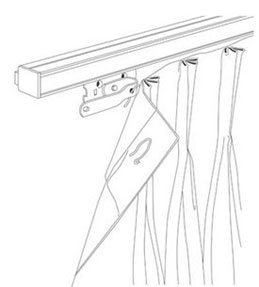Measuring the Width
- If you already have a drapery rod, measure the distance between the finials (The decorative ends of the drapery rod).
- If you already have a track, measure the total length of the track.
- If you do not already have a rod or track, then you will need to determine the total width that you would like your drapery to cover.
- Measure the width of the window and include the window frame.
-
When measuring the width to be covered, we recommend that you add between 4”-8” allowance to each side of the window measurement. You can add even more allowance if you want to create the effect of a wider window.
- By doing this, when the curtains are open they will not block as much of the glass and it will allow more light and make the window appear larger.
- Also, by adding these extra inches to the width, it will extend the drapery coverage and help keep out extra light when they are closed.
- We will automatically add the correct fullness to all of the drapery treatments depending on the style (from 200% to 225%). Fullness is extra fabric across the width of the drapery to provide a richer look and increase light and sound absorption.
Measuring the Length
-
If your drapery rod is not already in place, you will first need to determine the height at which you want to place your drapery rod.
- Measure from a minimum of 4” and a maximum of 12” above the top of your window (not including tabs or rings) to create a professional look and to give the illusion of height. This will become the placement height of your drapery rod.
- Pleats and grommets are included in the length you order.
Drapery Panel Length Tips:
- You can specify any length desired to the 1/4".
- For uneven floors, make sure to measure each side and submit the smallest measurement.
-
For floor length drapes, you have some options:
- A classic, clean look is to have the drapes end ½” above the floor or just touching the floor.
-
For a more luxurious look on drapery panels that will be stationary, you can add 1”- 10” to the drapery panel length so that they “puddle” on the floor.
- 1” Puddle is sometimes called a “trouser break”. It is a clean look that just touches the floor.
- 2”-4” Puddle is a more common puddle length with just a slight spilling of fabric onto the floor.
- 5”-8” Puddle creates a full look with enough fabric to fan the fabric over the floor.
- 10”+ Puddle is the most luxurious and is typically used in very formal settings.
- Puddling is not recommended for drapes that will be open and closed on a regular basis.
-
For sill length drapes, you need to decide if you want the length to the sill or just below the sill.
- If you choose “to the sill”, measure the length to the top of the sill.
- If you choose “below the sill”, measure the length an inch or two below the bottom of the sill.


